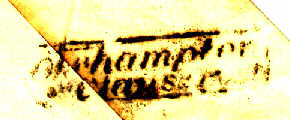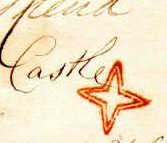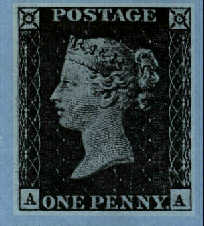British Postal History
We have been interested in British Postal History for years, and have obtained a good few reference books to help identify what we collect. We do not set ourselves up as experts, but will be most happy to try to answer any queries you may have on our subject.Our main area of expertise is before the Penny Black, which was introduced in May 1840, but our reference books cover a lot more than that period. So, if you are interested and would like to share information, feel free to e-mail us at the address below.
|
200 Years of British Postal Markings, 1668-1868
based on items we have seen or owned
Illustration | Description |
 Bishop Mark | BISHOP MARK The first type of British postmark, introduced in 1661, at the London Chief Office in Bishopgate Street while Henry Bishop was Postmaster General from June 1660 till April 1663. Designed to show the day of the month that the letter was posted, the Bishop Marks survived into the late 1780's. |

Free Frank | FREE FRANKS The Parliamentary Franking System. The origin of the Franking system was a decree of the Council of State in 1652, by which correspondence to and from Members of Parliament and of certain State Officials was permitted to pass free through the post. For detailed information about this type of postmark click on the image Free Frank |

Ship Letter | SHIP LETTERS. Early in the 18th Century, the Post Office had its own vessels under contract, carrying mail between England and the continent and also Ireland. Vessels under Post Office control were called Packet Boats and letters carried on them were called Packet Letters. Letters carried on privately owned ships under no agreement for the carriage of mail, were termed Ship Letters. For detailed information about this mark, click on the image Ship Letter |

Additional ½d | SCOTTISH ADDITIONAL HALFPENNY MAIL TAX, 1813 - 1839. By an Act of Parliament, all mail-carrying vehicles of any kind, and even horses, carrying the mail, were, from July 15th, 1785 exempted from paying tolls for "their passage through any Turnpike, Tollgate or Bar". As much of the revenue needed for the upkeep of the roads, particularly in remote places, was derived from this source, the Act caused a flood of complaints...... For detailed information about this type of postmark click on the image Additional ½d |
 | MILEAGE MARKS In 1784 new postal rates were introduced which made the distance a letter was carried more important, and the mileage from London began to appear in Provincial Postmarks. Abbreviated names occur and there are varieties with the mileage number after, above or below the office name. |
 Too Late | TOO LATEThe 'TOO LATE' stamp was adopted by the Post Office as a counter measure against the complaints from the general public of delayed delivery. The collection times of the mails were advertised, and if letters were received after the stated time, and the sender did not intend to pay the additional 'Late Fee' charge, the letters received the 'TOO LATE' stamp. These stamps varied from town to town and are an interesting study. If the letter is complete, the other postmarks also add to the story. For detailed information about this type of postmark click on the image on the left. Too Late. |
 London Marks London Marks | LONDON MARKS In the course of these 200 years there were two postal systems for London, the General Post and the Penny Post. These systems were run concurrently, but had different offices, staff, acccounting and of course, different postal markings. It is such a large section that we have split them into smaller sections on the following pages. They cover the Branch Offices of the General Post; Receiving Houses for both services; Foreign section of the General Post; and the various PAID and UNPAID handstamps used over this period. |
 | UNIFORM 4d From December 5th, 1839, a General Fourpenny Rate was set up for letters up to half an ounce in weight. The Fourpenny Post lasted only from December 5th, 1839 to January 9th, 1840 and markings were applied in manuscript or handstruck. For detailed information about this type of postmark click on the words on the left. Uniform 4d. |
 Local Posts | LOCAL POST In 1764, authority was given by Parliament to the Postmaster General, to establish in any city or town, a local Penny Post similar to that in existence in London.... For detailed information about this type of postmark click on the image Local Post |

| 5th CLAUSE POST. By the mid 1830's penny post offices were operating throughout the entire United Kingdom. Whereas it was a costly business to send a letter about 30 miles distant or more by the General Post, the local posts were able to provide a splendid service for one penny - and this was a uniform rate for both letters and packages weighing up to 4 ounces. Even villages and hamlets remotely situated and away from the post roads were helped by a service called a 'fifth clause post', so named after the fifth clause of the Act of 1801, which allowed any village not belonging to a post town to be linked up with its nearest post town - provided it was able to pay for the service. To view a cover with this mark click on the image '5th Clause post' |
 | Instructional Marks, London General Post.
Crowns, stars, crosses etc were used as official confirmation of a change in the rate applied to a letter. Some were also applied in Edinburgh, Dublin, Brighton and Glasgow. | General information |
Before the Penny Black
|
‘Before the Penny Black’ Read a general overview of the British Postal system before the introduction of the adhesive postage stamp. Click here to read the whole story |
'crossed' letters |
Why did they write like this? Prior to the introduction of the Penny Postage in 1840, one of the factors affecting the cost of posting a letter was whether it was a single sheet of paper. Two sheets would double the cost. That might not sound like a big problem, looking from the year 2001, but at that time the cost of sending letters had escalated to such an extent that if you could write twice on the same sheet of paper, you could in effect, send two sheets for the cost of one. We have actually got one letter that was written on 3 times - and it is a nightmare trying to decipher that one! Click here for the rest of the story Crossed letters click the image for details |
We will be updating this, so if you have any particular British postmark in which
you are interested, please e-mail us. We suggest you bookmark the site and re-visit.
Contact us here